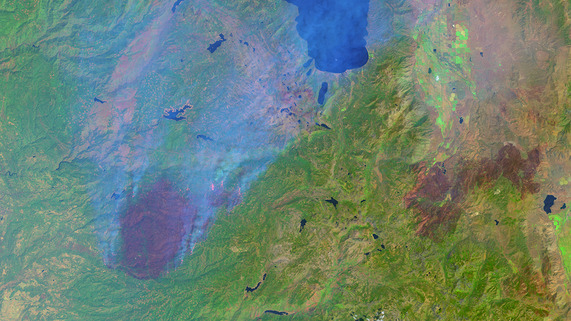|
The Department of the Interior recently announced $236 million in funding allocations from President Biden’s Investing in America agenda to support wildland fire management into fiscal year 2025 across the nation. The funding will help reduce risk from wildfires, support improved wildland firefighter training, expand efforts to rehabilitate burned areas in collaboration with partners, and advance wildfire science.
This announcement brings the total the Interior Department has allocated for wildland fire management from the Bipartisan Infrastructure Law to nearly $1.1 billion across the nation since it went into effect in fiscal year 2022.
These critical investments are supporting the nation’s wildland fire workforce, accelerating the pace and scale of fuels management and burned area rehabilitation, and advancing wildland fire science. Additional investments from the Bipartisan Infrastructure Law will continue through 2026.
Wildland fire personnel work in incredibly stressful environments that can have significant impacts on their health and wellbeing, including their mental health. To meet this challenge, together, the Interior and Agriculture departments are implementing a comprehensive Federal Wildland Firefighter Health and Wellbeing Program, directed by President Biden’s Bipartisan Infrastructure Law, to provide support tailored to the unique experiences and needs of our firefighters.
We are taking a holistic approach to the needs of our workforce with a focus on three key areas: behavioral health, environmental and occupational health, and physical health and readiness.
We know this program has been a long time coming. It is one of many efforts led by the Interior and Agriculture departments to make historic improvements for our federal wildland firefighting workforce. These improvements include increasing pay, creating a new occupational series to better define the unique duties and career progression of this profession, improving the availability and affordability of housing, streamlining hiring processes, and converting to a more permanent workforce.
The Joint Fire Science Program is seeking applications for nearly $11 million to advance wildland fire research and scientific exchange. Federal, state, Tribal, and local government agencies; other Tribal entities; academic institutions, non-governmental organizations, and private groups are eligible.
Funded by the Interior and Agriculture departments, the Joint Fire Science Program funds wildland fire research and supports the delivery of scientific findings to land managers and policymakers. The Bipartisan Infrastructure Law is providing additional funding to the program this year.
Proposals are due by September 19, 2024, through https://www.firescience.gov.
 The Biden-Harris administration is taking additional steps to safeguard western communities in the face of increasingly dangerous and intense wildland fires by building advanced wildfire detection capabilities using satellite technology.
The Department of the Interior and U.S. Department of Agriculture’s Forest Service have signed an agreement with the Department of Commerce’s National Oceanic and Atmospheric Administration to use the NOAA Geostationary Operational Environmental Satellite — R series data to rapidly detect and report wildfire starts. Supported by a $20 million investment from the President’s Bipartisan Infrastructure Law—$10 million each from Interior and Agriculture— this new agreement will use advanced remote sensing capabilities to improve the speed and accuracy of wildfire detection.
Use of NOAA’s GOES-R satellite data will enable the Interior and Agriculture departments to detect wildfires early, provide firefighters a more detailed look at wildfire conditions, allow faster hot spot detection, and provide the ability to track wildfire progression in real time.
An intern from Montana with the Demmer Scholar Program shares her experience working in wildland fire budget and policy at the Interior Department through a summer internship spent in the nation’s capital.
“Fire has always been a big part of my life. My parents met while on a fire crew in Colorado, so they constantly talked shop as I was growing up. Living in the West, I also experienced first-hand raging fire seasons almost every summer…
My time interning at the Office of Wildland Fire in DC.. has been a once-in-a-lifetime opportunity. Not only have I been able to fully immerse myself in the cultural landscape of the nation’s capital, but I have been at the perfect intersection of environmental education and real-world policy all summer long."
|